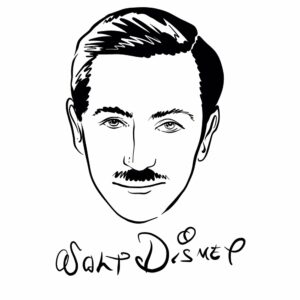Since the copyright to “Steamboat Willie” expired, the earliest versions of Mickey Mouse are now in the public domain. Does this mean everyone can grab the mouse, kick back, and let him create a media empire for them? Probably not. Where does value come from? According to what is called the physical fallacy, it comes from the transformation of material stuff into other material stuff. This is a serious mistake: as Deirdre McCloskey has argued, every good begins as an idea. IKEA furniture, for example, is not valuable because of the physical material that goes into it. It gets its value from people’s ideas about how to use those materials to make people better off.
Thomas Sowell points to a particular instance in his classic book Knowledge and Decisions. A guy named Walt Disney had created a character called Oswald Rabbit that had gained popularity. His studio, owning the copyright and thinking they didn’t need Disney to make successful Oswald Rabbit cartoons, shut him out. They thought Disney’s income came from superfluous charges above the “real” costs of making the cartoons. They reasoned that they could make money without Disney’s input once they had the character and the animators.

Except, of course, that isn’t what happened. Oswald Rabbit flopped, and a new character Disney created (and made sure he owned) called Mickey Mouse succeeded. As Sowell points out, the value of Oswald Rabbit (and later Mickey Mouse) was not the product of the material means of production conditioning creators’ minds. It was the product of Disney’s creativity and vision. When the studio told him to get lost, they ultimately hurt themselves–but undeterred, Disney pressed on and revolutionized entertainment. Without Walt Disney’s stories, Oswald Rabbit died.
“But they don’t make anything.” That’s not true. Writers, animators, and storytellers might not transform matter, but they create value where it didn’t exist before by finding new ways to entertain people. Collectors and dealers form a mini-industry evaluating, appraising, and moving their creations from lower to higher value uses.
“But without intellectual property law, Disney wouldn’t be the behemoth it is today.” That’s probably true, and intellectual monopoly is an unnecessary evil. However, Disney’s stock price did not plunge when Mickey entered the public domain and is, as of this writing, about 10% higher than it was when the copyright for “Steamboat Willie” officially expired. People have wondered what would have happened had the Super Mario Bros. video game franchise entered the public domain–as it would have a few years ago under old intellectual property rules.
This example suggests that it is dangerous to appoint moral and intellectual surrogates to decide on behalf of people they may not know and in response to incentives that do not reward them for being right or punish them for being wrong. Fortunately, Disney found a new outlet for his creative genius. it makes me wonder how much culinary, creative, and technological genius the world has wasted because someone had power, a particular vision, and poor incentives.
Art Carden is Professor of Economics & Medical Properties Trust Fellow at Samford University, and he is by his own admission as Koched up as they come: he has an award named for Charles G. Koch in his office, he does a lot of work for and is affiliated with an array of Koch-related organizations, and he has applied for and received money from the Charles Koch Foundation to host on-campus events.


READER COMMENTS
Thomas L Hutcheson
Mar 6 2024 at 2:17pm
I’ve never heard about the “physical fallacy.” It was not covered in Econ 101 through PhD at least back in the ’60’s-’70’s. Is it new? Maybe invented by the WSJ editorial pages?
Jon Murphy
Mar 7 2024 at 10:24am
I don’t know when the term itself came about, but the idea that is the physical fallacy has been discused at least as far back as Adam Smith. I think, for economists, it’s like a fish in water. We are so versed in avoiding the physical fallacy that we just don’t think about it too much.
Ron browning
Mar 7 2024 at 7:40am
In Thomas Sowell’s 1980 “Knowledge and Decisions” the “Physical Fallacy” is covered in pages 67-72 of the 1996 edition.
David Seltzer
Mar 8 2024 at 6:47pm
Art: Interesting. “Every good begins with an idea.” The Black-Scholes model has been called the trillion dollar equation. I was one of Fischer’s research students when I was in the MBA program at the University of Chicago. I had an undergrad degree in applied math and did a lot of programming in BASIC and FORTRAN. I recall; Myron and he were on a conference call. He pulled out a sheet of paper with the differential equation he derived. They discussed how it could be applied to option pricing. Of course it culminated in the pricing model. The human mind. What a resource!
Comments are closed.